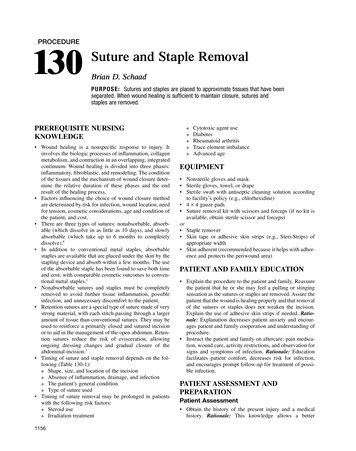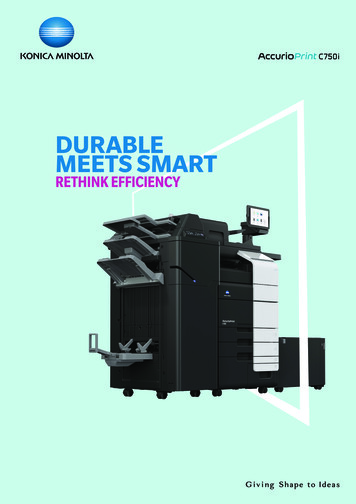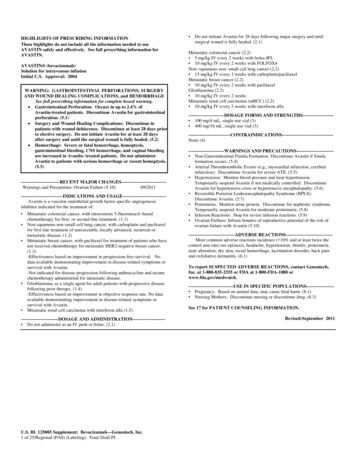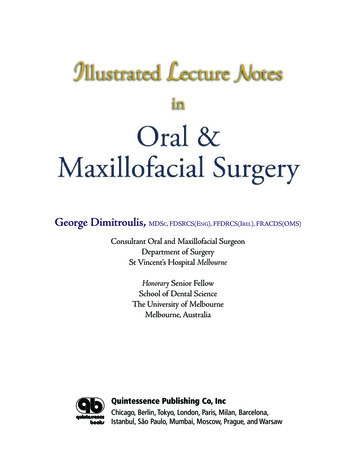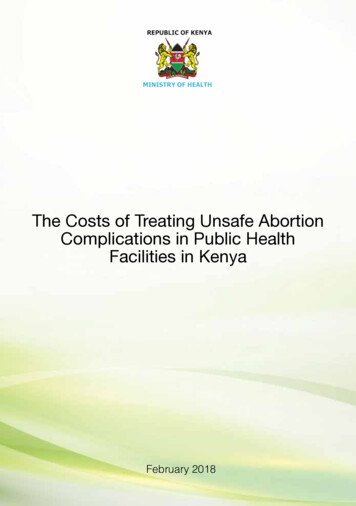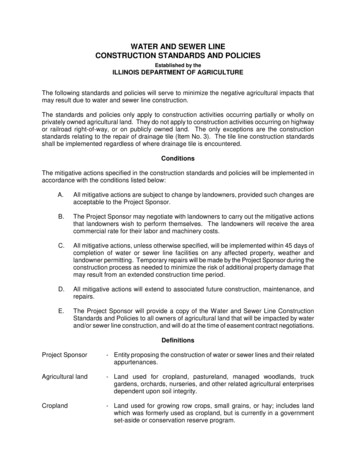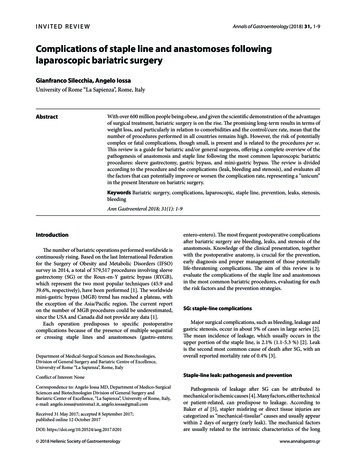
Transcription
INVITED REVIEWAnnals of Gastroenterology (2018) 31, 1-9Complications of staple line and anastomoses followinglaparoscopic bariatric surgeryGianfranco Silecchia, Angelo IossaUniversity of Rome “La Sapienza”, Rome, ItalyAbstractWith over 600 million people being obese, and given the scientific demonstration of the advantagesof surgical treatment, bariatric surgery is on the rise. The promising long-term results in terms ofweight loss, and particularly in relation to comorbidities and the control/cure rate, mean that thenumber of procedures performed in all countries remains high. However, the risk of potentiallycomplex or fatal complications, though small, is present and is related to the procedures per se.This review is a guide for bariatric and/or general surgeons, offering a complete overview of thepathogenesis of anastomosis and staple line following the most common laparoscopic bariatricprocedures: sleeve gastrectomy, gastric bypass, and mini-gastric bypass. The review is dividedaccording to the procedure and the complications (leak, bleeding and stenosis), and evaluates allthe factors that can potentially improve or worsen the complication rate, representing a “unicum”in the present literature on bariatric surgery.Keywords Bariatric surgery, complications, laparoscopic, staple line, prevention, leaks, stenosis,bleedingAnn Gastroenterol 2018; 31(1): 1-9IntroductionThe number of bariatric operations performed worldwide iscontinuously rising. Based on the last International Federationfor the Surgery of Obesity and Metabolic Disorders (IFSO)survey in 2014, a total of 579,517 procedures involving sleevegastrectomy (SG) or the Roux-en-Y gastric bypass (RYGB),which represent the two most popular techniques (45.9 and39.6%, respectively), have been performed [1]. The worldwidemini-gastric bypass (MGB) trend has reached a plateau, withthe exception of the Asia/Pacific region. The current reporton the number of MGB procedures could be underestimated,since the USA and Canada did not provide any data [1].Each operation predisposes to specific postoperativecomplications because of the presence of multiple sequentialor crossing staple lines and anastomoses (gastro-entero;Department of Medical-Surgical Sciences and Biotechnologies,Division of General Surgery and Bariatric Centre of Excellence,University of Rome “La Sapienza”, Rome, Italyentero-entero). The most frequent postoperative complicationsafter bariatric surgery are bleeding, leaks, and stenosis of theanastomosis. Knowledge of the clinical presentation, togetherwith the postoperative anatomy, is crucial for the prevention,early diagnosis and proper management of those potentiallylife-threatening complications. The aim of this review is toevaluate the complications of the staple line and anastomosesin the most common bariatric procedures, evaluating for eachthe risk factors and the prevention strategies.SG: staple-line complicationsMajor surgical complications, such as bleeding, leakage andgastric stenosis, occur in about 5% of cases in large series [2].The mean incidence of leakage, which usually occurs in theupper portion of the staple line, is 2.1% (1.1-5.3 %) [2]. Leakis the second most common cause of death after SG, with anoverall reported mortality rate of 0.4% [3].Conflict of Interest: NoneStaple-line leak: pathogenesis and preventionCorrespondence to: Angelo Iossa MD, Department of Medico-SurgicalSciences and Biotechnologies Division of General Surgery andBariatric Center of Excellence, “La Sapienza”, University of Rome, Italy,e-mail: angelo.iossa@uniroma1.it, angelo.iossa@gmail.comDOI: https://doi.org/10.20524/aog.2017.0201Pathogenesis of leakage after SG can be attributed tomechanical or ischemic causes [4]. Many factors, either technicalor patient-related, can predispose to leakage. According toBaker et al [5], stapler misfiring or direct tissue injuries arecategorized as “mechanical-tissular” causes and usually appearwithin 2 days of surgery (early leak). The mechanical factorsare usually related to the intrinsic characteristics of the long 2018 Hellenic Society of Gastroenterology www.annalsgastro.grReceived 31 May 2017; accepted 8 September 2017;published online 12 October 2017
2 G. Silecchia and A. Iossastaple line (approx. 20 cm). The phenomena of tissue creep,stress relaxation, and shear stress are dependent upon onecommon factor, which is time. Hence, optimal stapling shouldallow adequate time for tissue compression and creeping whilepreventing excessive tensile stress. Usually, waiting at least15 sec before firing helps to optimize this concept and allowadequate pre-cut compression time [5]. The choice of adequatecartridge is essential and many studies have been publishedon this topic, showing a great variability in the stomach wallthickness, related to the portion of the stomach (from antrumto fundus), sex, and the procedures (primary or revisional).Based on the latest evidence, proper cartridge selection amongthe several options offered on the market by the two majorbrands (Ethicon Echelon Stapler-Echelon Flex Endopath Stapler, Ethicon Endo-Surgery, Inc., Cincinnati, OH, USA; andCovidien Endo GIA Reloads with Tri-Staple TechnologyCovidien, Dublin, Ireland) is challenging in the absence ofroutine intraoperative measurement of gastric wall thickness.The appropriate cartridge “colors” using the Stapler-EchelonFlex Endopath Stapler at the antrum, midbody, and fundusin both patient groups (male/female) seem to be black, black,and blue, respectively [6]. In contrast, with the Endo GIA Tri-Staple the appropriate cartridge colors appear to be black,black, and purple respectively, although the black cartridgefor the antrum with this technology is completely appropriatein only 1 of every 6 female patients [6]. Despite the evidence,many surgeons use different colored cartridges, or use the samecolor for the entire staple line in combination with differentkinds of stapler reinforcement (suture, glue, buttress materials).In the absence of current guidelines, the only assumption isthat 81% of the panel experts of the international consensussummit for SG believe that it is not appropriate to use stapleswith a closed height less than that of a blue load (1.5 mm open)on any part of the SG [7]. When using these devices to createa long staple line, the surgeon must search for and remove themigratory “crotch” staple [5]. Failure to notice and remove thiscrotch staple may result in a staple misfire.It is strongly recommended to maintain an adequatedistance from the gastroesophageal junction in order toavoid ischemic complications related to the transection of thesegmental vascularization of this area, where the majority ofleaks occur (Fig. 1), although the ischemic theory of leak is notso strongly confirmed by the recent literature [8].The choice of bougie size (between 32 and 40 Fr) couldworsen the leak rate by creating an overpressure inside thepouch. A meta-analysis of Parikh et al, including 198 leaksin 8922 patients, revealed that the risk of leak decreased witha bougie 40 Fr, with no difference in percentage excessiveweight loss between a bougie 40 Fr and a bougie 40 Fr up to36 months [9]. This strong evidence supports the use of 40 Frbougies to decrease the leak rates, with controversial effects onweight loss [9-11].The distance from the pylorus varies from 2-6 cm andis related to a variable leak rate attributed to the higherintragastric pressure obtained after antral resection. Increasingthe size of the resected antrum might be associated with bettershort- and mid-term weight loss results, but could increase theleak rate [11-13]. Recalling that the bougie is only an inferiorAnnals of Gastroenterology 31 Figure 1 Sleeve gastrectomy: leakresecting limit, the principal rule for avoiding overpressurein the sleeve is the critical orientation of the created sleeve,respecting the incisura and the staple-line orientation, togetherwith a correct choice of bougie [4]. The creation of a gastric tubethat is not cylindrical in shape results in high pressure, especiallyat the most proximal corner of the staple line (Laplace’s Law)and thus results in a higher probability of leak in the proximalthird of the tubular stomach. A spiral-shaped staple line canresult in functional obstruction; in addition, stapling too closeto the incisura can result in anatomical narrowing, creating ahigh-pressure system; both are preventable causes of leak thatcan potentially result in a high-pressure system [4].The leak rate is also related to the surgical experience,as reported by Noel et al [14]. The authors analyzed theirexperience in two groups, Group A (first 900) and Group B(last 900 laparoscopic SG [LSG]), showing a critical decrease inleak rate from 2% to 0.2%, (P 0.001).Regarding staple-line reinforcement (SLR) as a leakreducing option, several tools have been proposed, includingthe following: oversewing, absorbable synthetic buttressmaterial (synthetic glycolide trimethylene carbonatecopolymer Gore Seamguard Bioabsorbable Staple LineReinforcement), biologic cross-linked buttressing (bovinepericardium strips, Peri-strips Dry and PSD Veritas Baxter),biologic non-cross-linked buttressing (absorbable) (porcinesmall intestinal submucosa, Surgisis Biodesign ), thrombinmatrix (Floseal , Baxter Healthcare), and fibrin glue (Tisseel,Baxter Healthcare). The current high-level evidence showedthat absorbable buttress materials applied on adequatecartridges appear to offer safer and more effective control ofstaple-line bleeding and leak (1.09% with Gore Seamguard [2]vs. 1.83% with Peri-strips Dry [15]) and an increased costcompared with non-reinforced staple lines, but at the same timesingle-center experience in a large population demonstratedexcellent results using fibrin glue as SLR (0%) [16], as well asthe inverting absorbable suture (Lembert’s suture) (0%) [17].Berger et al published the first report from the metabolicand bariatric surgery accreditation and quality improvementprogram (MBSAQIP), which evaluated the outcomes of
Complications of laparoscopic bariatric surgery 3189,477 patients who underwent SG with or without SLR [10],and demonstrated a negative effect of SLR on leak rate: 0.96%vs. 0.65% (odds ratio [OR] 1.20, 95% confidence interval [CI]1.00-1.43). Placement of drains does not facilitate the detectionof leak and/or abscess and they do not appear to eliminate thereoperation rates for these complications, which usually occurafter the patient’s discharge [18].A leak after SG represents a complex condition, hard tosolve and potentially life threatening, with a high additionalcost. Prolonged hospitalization in the ICU accounted forthe majority of hospital costs (58.9%), with a total cost of 304,290 [19].In conclusion, based on evidence in the literature, measuresfor the prevention of leak include the following: Use a bougie size 40 Fr Begin the gastric transection 5-6 cm from the pylorus Use appropriate cartridge colors from antrum to fundus Perform a proper staple line Remove the crotch staples Maintain proper traction on the stomach before firing Stay at least 1 cm away from the angle of His and 1.5 cmfrom the incisura Reinforce the staple line (buttress, glue and Lembert’ssuture)Staple-line bleeding: pathogenesis and preventionA long stapler line is mostly responsible for postoperativebleeding in 0-20% cases, with a re-operation rate of 1.4% formajor bleeding [20] (Fig. 2), while intraluminal bleeding isuncommon. Modifiable factors should be investigated andcorrected before surgery. Comorbidities, such as liver disease(non-alcoholic fatty liver), coagulopathy, hypertensionand super-obesity, increase the bleeding risk and shouldbe carefully evaluated and treated preoperatively whenpossible [21,22]. Patients who are candidates for SG as arevisional procedure, mainly after adjustable gastric bandfailure or complications, represent a high-risk subset. Basedon a “sleeve bleed calculator” published this year [23], theauthors concluded that the protective factors for hemorrhagiccomplications were no history of obstructive sleep apnea(OR 0.22; 95CI 0.05-0.94) and no history of hypertension(OR 0.38; 95%CI 0.14-1.05), while a low level of expertise inbariatric surgery (OR 2.85; 95%CI 1.08-7.53) and no stapleline reinforcement (OR 3.34; 95%CI 1.21-9.21) were associatedwith a higher risk of hemorrhagic complications. Anotherintraoperative bleed control protocol has been publishedrecently by De Angelis et al; it involves an adjustment of thesystolic blood pressure to 140 mmHg and a simultaneousreduction of the pneumoperitoneum to 10 mm/Hg in orderto identify the possible silent bleeding; the authors reported apost-operative bleeding rate of 0% [24]. The SLR seems to playa central role in bleeding, as was indicated by two high-levelevidence papers: in 2015, Shikora published a meta-analysisthat assessed four SLR options (no reinforcement, oversewing,bovine pericardial strips, and absorbable polymer membrane),showing bleeding rates of 1.16% and 2.09% with reinforcement(bovine pericardial strips and absorbable polymer membrane,respectively) compared with 4.94% and 2.41% for the noreinforcement technique and the oversuture, respectively [15].Recently, Berger, evaluating the outcomes of 189,477 patientsundergoing LSG with or without SLR, showed a positive effectof SLR on bleed rate: 0.75% vs. 1% (OR 0.74; 95%CI 0.630.86) [10]. There is evidence that using fibrin glue (bleed rate0.3%) [16] and inverting suture (0.1%) [17] leads to excellentresults; these need to be re-evaluated in large populations andbased on multicenter experience. Placement of drains does notfacilitate the detection of bleeding. Furthermore, they do notseem to reduce the reoperation rates for these complications. Itis possible that patients with previous laparoscopic adjustablegastric banding and intraperitoneal bleeding could benefitfrom placement of a drain that will remain for more than5 days [18].In conclusion, based on the evidence in the literature, theadequate prevention of bleeding includes the following: Reinforce the staple line (buttress, glue and Lembert’ssuture) Choose an adequate cartridge Control hemostasis with low intra-abdominal pressure andincreased systolic blood pressure ( 140 mmHg)Staple-line stenosis: pathogenesis and preventionFigure 2 Sleeve gastrectomy: staple-line bleeding. Re-laparoscopyStaple-line stenosis occurs in 0.7% to 4% of patients whoundergo LSG and often causes nausea, vomiting, epigastricpain and reflux; if untreated, it can lead to readmission [25].It has been suggested that mechanical gastric can be caused byretraction of scar, oversewing of the staple line, overtraction ofthe greater curvature during stapling, or small hematomas orleaks that heal as scar tissue [25]. Sharp angulation or a spiral ofthe gastric sleeve could result from an incomplete gastric sleevestenosis, or from other mechanisms such as asymmetricalAnnals of Gastroenterology 31
4 G. Silecchia and A. Iossalateral traction, with stapling leading to twisting of the gastrictube via a volvulus-like mechanism [25-27]. The site of stenosisis most often at the incisura angularis or gastroesophagealjunction [26,28] (Fig. 3). When a stenosis occurs, it is usuallyone of two types: a functional one (passage of the endoscope ispossible but the sleeve is twisted with various degrees of rotation,requiring the scope to be passed through the gastric lumen—the so-called helix stenosis) or a mechanical one (when thepassage of the endoscope is very difficult or impossible) [26].Stricture and kinking may be avoided by keeping a safe distancebetween the incisura angularis and the edge where the staplesare applied. In agreement with Manos et al, we believe thatleft-hand stapling offers the proper direction “to respect theincisura angularis” [26]. During left-hand stapling, the devicewill be parallel with the lesser curvature and not perpendicular,as is the case when performing right-hand stapling. Keepingthe staple line straight by resecting symmetrically anterior andposterior walls of the stomach represents the main factor foravoiding staple line twisting [26].In conclusion, in the majority of cases staple-line stenosisrepresents a technical error related to incorrect traction of thestomach during stapling, or an inappropriate distance from theincisura. Table 1 presents a summary of the complications.Gastric bypass: staple-line complicationsThe most common anastomotic complications after RYGBare bleeding, stenosis and fistula. These complications occurpredominantly at the gastrojejunal (G-J) anastomosis, withthe following incidence ranges: bleeding 1-4% [28,29], stenosis3-28% [28-30], and leaks 0.1-5.8% [28,29]. Several studies haveshown the leak-associated mortality to reach 37.5-50% [28-30].Staple-line leak: pathogenesis and preventionFigure 3 Sleeve gastrectomy: mid-gastric stenosisThe incidence of anastomotic leaks ranges from0.1-5.8% [28,29]. Patients may present with any combinationof abdominal pain, persistent tachycardia, shortness of breath,fever, hypotension, and unexplained sepsis. The leaks mostcommonly occur at the G-J anastomosis [28,29] but canalso occur at the gastric pouch stapler line, gastric remnant,or jejunojejunostomy. This is usually an early complication(most commonly within 1 week after surgery). In 2016 Varbanet al [31] published a retrospective analysis of the MichiganBariatric Surgery Collaborative, including 16,258 patients whounderwent RYGB, and reported the following results: accordingTable 1 Summary of staple-line complications after laparoscopic sleeve gastrectomy (SG)IncidencePathogenesisPreventionLeak2.1% (1.1-5.3%)Narrow tube ( 40 Fr bougie);Distance from AOH ( 1 cm);Twisted/stenotic tube;Staple misfiringBougie size 40 Fr;Distance from the pylorus 5-6 cm;Appropriate cartridge colors from antrum to fundus;Straight staple line;Crotch staples removal;Distance from AOH at least 1 cm and 1.5 cm from theincisura;Staple-line reinforcement (buttress, glue and Lembert’ssuture)Bleeding0-20%Patient-related factors:Liver disease, coagulopathy, hypertension,super-obesity, revisional surgerySurgeon-related factors:Low level of expertise, no staple-linereinforcementStaple line reinforcement (buttress, glue and Lembert’ssuture);Appropriate cartridge colors from antrum to fundus;Bleeding check with low intra-abdominal pressure andincreased systolic blood pressure ( 140 mmHg)Stenosis0.7-4%Oversewing of the staple line;Overtraction of the greater curvature duringstapling;Small hematomas or leaks that heal as scar tissueSymmetric/lateral traction of the stomach duringstapling;Distance of 1.5 cm from the incisuraAOH, angle of HisAnnals of Gastroenterology 31
Complications of laparoscopic bariatric surgery 5to the univariate analysis, cases with an increased bloodtransfusion requirement (OR 4.3; 95%CI 1.00-1.01, P 0.0015),conversions from laparoscopic to open surgery (OR 10.00;95%CI 1.17-85.59; P 0.0356), the use of buttressing material(OR 3.35; 95%CI 1.61-6.99; P 0.0013), and Covidien staplerbrand (OR 2.02; 95%CI 1.08-3.76; P 0.0268) were associatedwith a significantly higher rate of anastomotic leak. Conversely,the use of fibrin sealant over the G-J anastomoses was associatedwith a significantly lower rate of leaks (OR 0.37; 95%CI 0.170.79; P 0.0099). After multivariate analysis, only the use ofbuttressing material continued to be associated with a higherrate of leaks (OR 8.79; 95%CI 2.49-31.01; P 0.0007), whereasthe use of fibrin sealant was associated with a decrease in thelikelihood of leaks (OR 0.11; 95%CI 0.03-0.41 P 0.0013) [31].Contrary to those results regarding fibrin sealant, Ibele et al,in a retrospective study evaluating 529 patients (429 fibrinsealant group vs. 104 no), found a leak rate of 0.9% vs. 1.9%(P 0.2) [32]. Furthermore, regarding SLR, Shikora et al [15],in a recent meta-analysis evaluating the advantages of SLR ingastrointestinal surgery, showed that the leak rate in gastricbypass decreased progressively using SLR, reporting thefollowing percentages: no SRL 2.60%, oversuture 2.44%,glycolide copolymer 1.88%, bovine pericardium 1%. Asrecently reported in a meta-analysis that compared differentkind of G-J anastomosis [33], no significant differences wereobserved in leak and reoperation rate. Compared with circular(CSA), hand-sewn (HAS) anastomosis had a similar risk of leak(OR 1.65; 95%CI, 0.61-4.48; P 0.33; and reoperation (OR 0.50;95%CI 0.10-2.54; P 0.40). Compared with LSA, HSA also hada similar risk of leak (OR 1.46; 95%CI 0.72-2.96; P 0.29;), andreoperation (OR 1.03; 95%CI 0.52-2.04; P 0.94) (Table 2) [33].In conclusion, leaks after RYGB are not influenced by thetype of G-J anastomosis, but can be positively influenced bythe use of fibrin glue.Staple-line bleeding: pathogenesis and preventionBleeding usually takes place in the early postoperativecourse (within the first hours to days) [28]. The bleedingafter RYGB can originate at one of five potential staple lines:the gastric pouch, excluded stomach, Roux limb staple line,gastrojejunostomy, and jejunojejunostomy. Staple-line bleedingoccurs at the transected tissue edges or at the sites where staplespenetrate the tissue. In order of frequency, the sites of stapleline bleeding are 40% from the gastric remnant staple line,30% from the G-J staple line, and 30% from the jejunojejunalstaple line [28]. Interestingly, a meta-analysis comparingopen versus laparoscopic RYGB noted that the frequencyof bleeding was higher in the laparoscopic RYGB (LRYGB)series (1.8% vs. 0.7%) [34]. Some hypotheses to explain thisgreater incidence of bleeding in the LRYGB in the minimallyinvasive surgery era are the overuse of chemoprophylaxisfor deep vein thrombosis and the decreased in the practiceof oversewing the staple lines. Two types of postoperativehemorrhage have been noted to occur following LRYGB:intraperitoneal or intraluminal [28]. The latter usually occursas a late complication, while intraperitoneal bleeding occurs inthe early postoperative course. As with any bleeding associatedwith surgery, early diagnosis is crucial. The clinical signs andsymptoms are critical in determining the most appropriatesteps for managing this life-threatening complication.There are some potential methods for the prevention ofstaple-line bleeding. One method is to use a linear staplerwith a shorter staple height. For example, using a whitelinear stapler load (2.5 mm) instead of a blue stapler load(3.5 mm) for the creation of the jejunojejunostomy, or a bluestapler load instead of a green stapler load (4.8 mm) for thecreation of the gastric pouch [28]. The shorter staple heightprovides more compression of the tissues and hence results inbetter hemostasis. However, a shorter staple height does notcompletely prevent staple-line bleeding and it can increase therisk of leaking due to inadequate tissue approximation [28].Another method for prevention of staple-line bleeding is theuse of SLR. In a recent meta-analysis published by Shikoraet al, the authors concluded that the use of SLR guaranteeda lower incidence of bleed events, particularly using bovinepericardium (1.28% vs. 3.13% without SLR vs. 3.10% usingoversuture vs. 3.02% using glycolide copolymer) [15].Technical factors seem to be related to the incidence ofTable 2 Summary of staple-line complications after laparoscopic gastric o differences related to the type of anastomosis (circular,hand-sewn, linear)Controversial effect of reinforcement (protective/worsening)Fibrin glue on G-J anastomosis;Appropriate cartridgeBleeding1.3-3.1%Patient-related factors:liver disease, coagulopathy, hypertension, super-obesity,revisional surgerySurgeon-related factors:No staple-line reinforcement, mechanical circular anastomosisStaple-line reinforcement (buttress, glue);Linear or hand-sewn techniqueStenosis3-28%Local factors (ischemia, scar formation, and tension of the G-Janastomosis);G-J anastomosis technique;Marginal ulcerG-J anastomosis 21 mm; linear or hand-sewntechnique;Quit smoking and NSAID (marginal ulcerprevention)G-J, gastro-jejunal; NSAID, non-steroid anti-inflammatory drugsAnnals of Gastroenterology 31
6 G. Silecchia and A. Iossapostoperative bleeding from the G-J anastomosis, as wasdemonstrated by Jiang et al, in a recently published metaanalysis evaluating the outcomes of HSA vs. circular CSAor linear LSA anastomosis [33]. Compared with CSA, HSA(OR 0.48; 95%CI 0.31-0.74; P 0.001; Fig. 4) was associatedwith significantly less postoperative bleeding. There wasno significant difference between HSA and LSA (OR 1.27;95%CI 0.77-2.10; P 0.34) [33]. A recent report by Ichteret al [35] showed that using an EEA stapler reinforced withabsorbable synthetic material yielded excellent results interms of bleeding rate (0% in 125 cases) compared with thenot-reinforced group. Fibrin sealant seems to be a validoption for reducing postoperative bleeding, as was reportedby Silecchia et al in 2008 [36]. This multicenter randomizedtrial compared two groups of patients undergoing RYGBP, withor without fibrin sealant, and reported a 0% rate of bleedingfrom the G-J anastomosis in patients receiving fibrin sealant.The authors commented that the overall reintervention rate forearly postoperative complications (anastomotic leak, internalhernia, and anastomotic bleeding) was significantly higher inthe group that did not receive fibrin sealant (P 0.02). Recently,Ibele et al [32] found that 1.7% of patients in the sealant groupexperienced symptomatic postoperative bleeding requiringtransfusion of 2 units of blood, compared to 4.8% in the groupthat did not receive sealant (P 0.05), despite a high incidenceof stricture in patients treated with fibrin sealant on the G-Janastomosis (11.3 vs. 5.8%; P 0.04).In conclusion, staple-line bleeding after RYGB can becontrolled with the use of SLR or fibrin sealant, while a circularG-J anastomosis carries a potential risk for intraluminalbleeding.Staple-line stenosis: pathogenesis and preventionSymptomatic narrowing and stenosis of the G-J anastomosis(incidence: 3-28%) takes several weeks to a few months todevelop and render the patient symptomatic [28]. It is typicallyfollowed by such symptoms as dysphagia, nausea, vomiting,Figure 4 Gastric bypass: stenosis at gastrojejunal anastomosisAnnals of Gastroenterology 31 and gastroesophageal reflux (Fig. 4). The etiology remainsuncertain, but it seemingly depends on local factors (ischemia,scar formation, and tension of the anastomosis) and on thetechnique used to create the G-J anastomosis (i.e. hand-sewn,circular versus linear stapler, and size of stapler) [28,33]. Forexample, Nguyen et al reported a higher rate of stenoses usinga 21 mm (26.8%) compared to a 25 mm (8.8%) circular stapler,with no effect on weight loss [37]. Another factor that hasbeen shown to reduce the incidence of strictures is the handsewn construction of the gastrojejunostomy. Comparativestudies of a circular mechanical anastomosis versus a handsewn anastomosis showed significantly greater stenosis ratesin the circular stapler group (31% vs. 3%) [30]. Linear staplersare also used for construction of the gastrojejunostomy, withthe reported stricture rate being between 3.1% and 6.8%—lower than the rate quoted for circular staplers [30]. Despitethe recently published data, a meta-analysis comparingthe outcomes between hand-sewn vs. mechanical G-Janastomosis showed no difference in terms of postoperativestricture [33]. Interesting, applying fibrin sealant to the stapleline, particularly to the anastomosis, seems to worsened thestricture rate, as recently reported by Ibele et al (11.3% with vs.4.8% without fibrin sealant P 0.04) [32]. A central role in thepathogenesis of stenosis is played by the marginal ulcers, whichhave an incidence of between 0.6% and 16% [30]. Severalprevious studies attempted to define potential risk factorsfor the development of marginal ulcers, but it still remains acontroversial topic [30,38]. There is currently no evidencefor an association between the development of marginalulceration after RYGB and the presence of Helicobacter pylori(H. pylori) infection [30]. H. pylori appears rather to cause aninjury to the gastric mucosa preoperatively that potentiates theformation of marginal ulcer after gastric bypass. Therefore,H. pylori eradication is recommended prior to surgery. Othercauses include smoking and alcohol consumption; use of nonsteroid anti-inflammatory drugs (NSAID); diabetes; excessacid exposure due to creation of a too-large gastric pouch, todilatation of the gastric pouch over time, or to the presenceFigure 5 Recurrent marginal ulcer at gastrojejunal anastomosis afterfibrin healing
Complications of laparoscopic bariatric surgery 7of a gastrogastric fistula; presence of foreign bodies, such asnon-absorbable sutures or staples; and local factors, such asischemia, or tension at the G-J anastomosis [30,38]. Even ifmarginal ulcers are multifactorial, the development of earlymarginal ulcer is more likely to be associated with local factors(ischemia, postoperative inflammation, stenosis, or foreignbody) while late marginal ulcers are likely to be related to anincreased acid exposition of the G-J anastomosis developingover time (Fig. 5) [30,38-39]. Zollinger-Ellison syndrome alsohas to be ruled out. In their review of 3430 procedures of RYGB,Felix et al identified 35 cases of perforation (1%) with a mediantime to perforation of 18 months (range 3-70 months) [40].Wendling et al have recently described the most delayed onsetof perforated ulcer found in the literature, occurring 98 monthsafter the original surgery [41]. In the study by Felix et al theincidence of smoking was significantly higher and the use ofNSAID and steroids was common in patients presenting witha perforated ulcer [40].In conclusion, stenosis has an incidence related to thetechnique (circular stapler vs. hand-sewn vs. lin
survey in 2014, a total of 579,517 procedures involving sleeve gastrectomy (SG) or the Roux-en-Y gastric bypass (RYGB), which represent the two most popular techniques (45.9 and 39.6%, respectively), have been performed [1]. The worldwide mini-gastric bypass (MGB) trend has reached a plateau, with the exception of the Asia/Pacific region.
